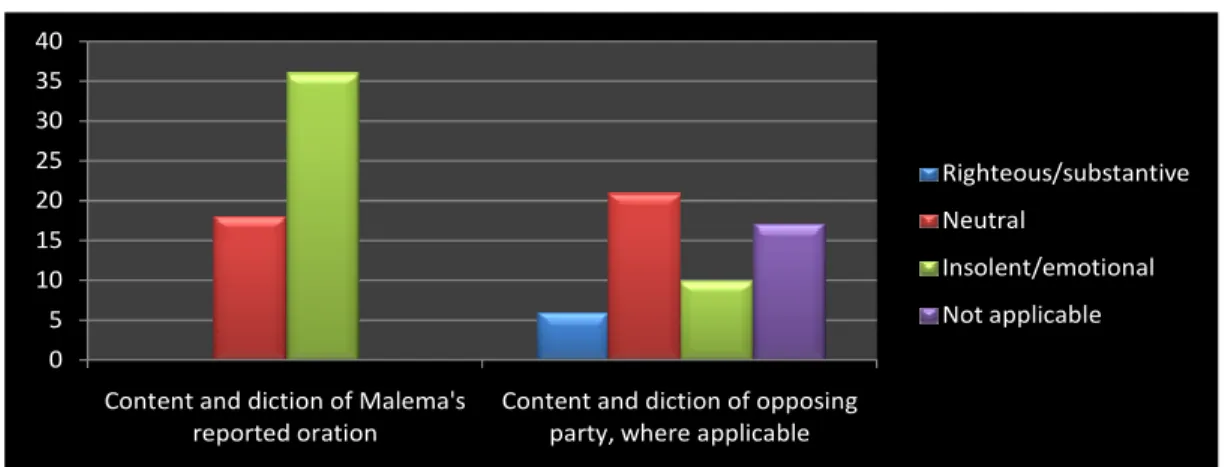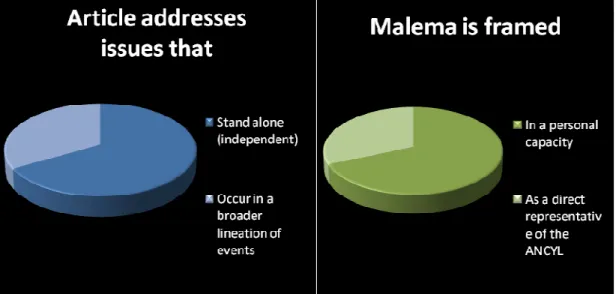By studying the portrayal of Malema, this research aims to shed light on the activities of the press. In mapping the reporting of a strongly mediated Julius Malema, the research is aimed at unmasking his representation, which enables insight into the contemporary exploitations of the press. The scope of the study will be limited to portraying an individual, thus allowing for highly limited findings.
In order for this study to contribute to the current superimposed body of knowledge on the press's characterization of the South African political elite, it must incorporate relevant and appropriate theories and models. Thus, the images on which the media focuses become visible in the eyes of the public and thus determine their thinking. Similar to framing, agenda-setting theory focuses on the salience of the story being reported by the media.
The image of an individual, regardless of the angle from which it is portrayed, therefore remains internally oblique in its limitation. This provides structure of understanding to both the consumer of the story as well as the purpose of this study. By asking clear questions about the content of the text, the frame is reduced to one that is comprehensible.
Priming is mainly used by the author to capture the attention of the audience to sell a story.
Research Methodology
With Wasserman, de Beer and Hyde-Clarke considering the orientation of the press to be conflict-focused as well as largely Afro-pessimistic (Wasserman & de Beer, 2005, p. 193; Hyde-Clarke, 2010, p. 41), This study aims to empirically examine the extent and character of the political power of the press through the following research question: does the South African press portray Julius Malema antagonistically. Public spat, including two-way name-calling, between Malema and DA (Democratic Alliance) leaders, most notably DA leader Helen Zille (24 February 2009). Incendiary Remarks Made Between Malema and South African Communist Party General Secretary Jeremy Cronin (20 November 2009).
Malema's singing of the song Dibul' Ibhunu (Shoot the Boer), including the line where applicable (10 March 2010). One is The Sowetan, a Gauteng-based left-wing newspaper born out of the liberation struggle when it was, and perhaps still is, sympathetic to the ANC. The weekday editions of these two newspapers were selected covering a broad spectrum of the South African newspaper establishment.
The units of analysis are all articles relating to Malema and the five separate events written by staff journalists and published in the daily editions of The Sowetan and The Cape Times. To ensure that appropriate content was available for analysis, at least three articles directly relating to Malema had to appear in each newspaper throughout the week. Content analysis is as Titscher suggests (as cited in Hyde-Clarke, 2011, p.46) "the longest established method of text analysis among the group of empirical methods of social inquiry". This technique allows the researcher to track trends in the media, using both quantitative and qualitative elements.
This "theoretical triangulation," says Denzin (1970), allows for greater interpretation of the data while ensuring its regularity. This is done to provide a verbatim display of the words used in the various newspapers. The variables are selected to provide clear categorizations of the semantic value of the texts.
The sharply chosen qualitative coding process imparts the intrinsic meaning and richness of the validating quantitative data to be extracted. The underlying meaning of the text is brought out through the collaboration of qualitative and quantitative analysis. The quantitative analysis according to the objectives of the study depends on semantic categorization and subsequent numerical computation to make it possible.
Methodological Results A. Tables
With an average exceeding one article per investigative day in both weekdays, this cross-section of the press clearly shows Malema's depiction of controversial events to be prioritized. It is definitely impressive that this youth leader has such a presence in the eyes of the press and then in the minds of the public. Given that the issues tracked here are contentious, it is surprising that Malema received so much coverage when the issues were presented as "valenced," the valence that was a core dimension of the press agenda reinforcing the barrier.
Despite the appearance of the 'objective' tone, the stark difference between 'degrading' and 'flattering' descriptions deserves attention. With Figure 1 providing a view of the framework of the issue at hand which is relatively stable, it is significant to note the agenda set out in a tone that Malema presents in a disapproving manner. Mostly, however, where applicable, the content and diction of the opposing party is reported as 'neutral', with some retorts being 'substantive'. This balanced neutrality indicates a softer touch in dealing with the opposing party.
Drawing extensively from Entman's description of framing, being the driving force behind the communicating text, depiction is informed by what evaluates and diagnoses the content of the article (Entman, 2004, p. 1). Although only the denotative meaning of the texts is drawn upon, recognition must be given to the fact that only one researcher examined the work, more researchers might have contributed to greater consistency. The predominance of the 'unfair' frame in Figure 3 is superior to the 'neutral' one, while its depiction is presented as 'fair' on only one occasion. Malema's frame throughout the study is therefore one of deviance.
When the opposing side is framed in response, and especially when no other side is framed, the press can be seen to function as a player in the game, offering resistance through its portrayal of the central player. Aligned with the "game frame," Wolfsfeld's model of political competition suggests that when one frame is promoted against another, the result is the political influence of the party being promoted (Wolfsfeld, 1997, p. 2). By influencing the portrayal of the parties involved, the press acts as a moral force that explicitly encourages or degrades.
However, the political contest model also highlights the profit-seeking aspects of the press, as seen in Herman and Chomsky (1988), where the business media explicitly distorts reporting to accommodate the profit motive. By decontextualizing the reader from the setting, the episodic frame offers a more dramatically immediate reading of the event. Thus, if an event is told in a rushed or ominous way, its broader contextualization will enable greater conceptualization of the issue, which will ensure greater press responsibility.
The degree and character of the political power of the press is best expressed in the consistently disapproving way in which Malema is framed. The character of the press illustrates a counterforce, the exalted nature of mediatization and the authority of heightened media logic that affords it great freedom of choice.

Discussion
This adjustment came at a time when the differing views of the ANC and the press seemed irreconcilable, and the press in particular came under pressure for the way it treated individuals. This improvement of the code, accompanied by the suspension of the Media Appeals Board, indicates a possible improvement between the political establishment and the press. The findings of this survey are in line with the revised press code and support the call for more accountability of the press, particularly in support of the renewed focus on the representation of the individual.
Political attitude and the need for peace journalism in South Africa: The case of Julius Malema. Think about it this way: Assign an agenda-setting function to the press and the public's evaluation of local issues. A historical exploration of the personification of politics in the print media: The British prime ministers.
